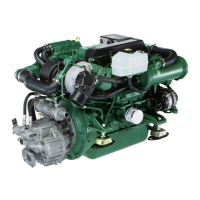10
There are two types of instrument panel: the main
panel and the secondary helm panel. The alarm pa-
nel and the main switch can in some cases be in-
stalled separately.
Main panel
Instruments
1. Rev counter
This shows the engine speed in revs per minute x
100.
Speed
It is important that the engine reaches a maximum
speed of 3900, or as near this speed as possible,
with a normal load. A recommended maximum
cruising speed is around 200 r/min below the maxi-
mum speed achieved.
Note! Growth on the hull reduces the speed.
2. Operating hours
Shows the number of operating hours in hours and
tenths of an hour.
3. Temperature gauge
During normal use, the temperature gauge should
display 75–90°C (165-195°F). The alarm will sound
if the cooling water temperature is too high.
If the alarm comes on, reduce the speed
to idling in neutral. Check the reason for
the alarm, if neccessary stop the engine
and repair the fault.
4. Oil pressure gauge
The oil pressure gauge should normally show 300–
500 kPa (45-75 psi) when the engine is running. It is
normal for the gauge to show a lower reading at lo-
wer speeds. An acoustic alarm will sound if the oil
pressure is too low.
If the alarm comes on, stop the engine
immediately and determine the cause.
5. Voltmeter
The voltmeter shows the system voltage. When the
engine is running, this is ca 14 V in a 12 V system
and ca 28 V in a 24 V system. The voltages are 12
and 24 V respectively when the engine is switched
off.
6. Alarm
Sounds if the engine oil pressure is too low, if the
coolant temperature is too high or if the generator is
not charging.
7. Warning display
The panel has four windows which light up red to in-
dicate the reason for the alarm, the acoustic alarm
signal also sounds:
345
12 867109
Panel for auxiliary controls
12869
710

